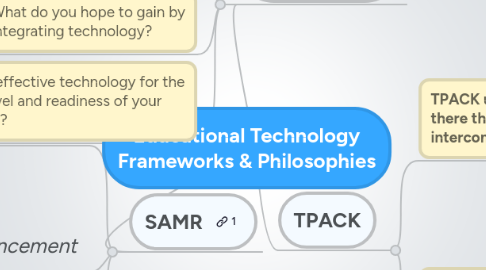
1. SAMR
1.1. Transformation
1.1.1. Redefinition
1.1.1.1. The addition of technology allows for creation of new tasks that were previous not foreseen.
1.1.1.1.1. Getting students to utilize the lino tool to present their final projects. Then getting them to post a link to it in a Google docs to allow other students to reference in the future.
1.1.2. Modification
1.1.2.1. Technology allows the task to be significantly redesigned.
1.1.2.1.1. Using Twitter as a means to collect answers from students at home in regards to a question asked in class.
1.2. Enhancement
1.2.1. Augmentation
1.2.1.1. When added, technology serves to substitute and adds some functional change to the task at hand.
1.2.1.1.1. For example: Using Google/Bing or any other search engine to find information instead of referencing an encyclopaedia.
1.2.2. Substitution
1.2.2.1. No functional change to task when technology is substituted in place of the original idea.
1.2.2.1.1. Using Microsoft Excel to graph charts and input equations instead of using pencil, paper and regular calculators.
1.3. Uses a four part system that shows how integrating technology in the classroom can improve the quality of instruction and presentation while increasing student engagement and success.
2. Philosophy of TEACHnology
2.1. Similar to the Philosophy of teaching.
2.2. How are you going to successfully integrate technology into your classroom?
2.3. What kinds of technology out there can support your content, improve student engagement and improve their learning?
2.4. What do you hope to gain by integrating technology?
2.5. What is effective technology for the grade level and readiness of your students?
3. TPACK
3.1. TPACK uses a ven diagram to show how there three types of knowledge are interconnected.
3.1.1. Pedagogical Content Knowledge
3.1.2. Technological Content Knowledge
3.1.3. Technological Pedagogical Knowledge
3.2. Three Kinds of Knowledge Teachers Must Have
3.2.1. Content Knowledge
3.2.1.1. The knowledge of the subject matter.
3.2.2. Pedagogical Knowledge
3.2.2.1. Knowing how students learn, how we teach and how we assess their learning.
3.2.3. Technological Knowledge
3.2.3.1. Digital literacy with educational technologies and how to incorporate already existing technology in a meaningful way in our classroom.
